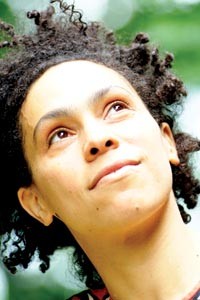August-afternoon heat notwithstanding, Grisha Coleman asks to go outside to discuss echo::system -- The Desert, her work combining live performance and high-tech installation art. The mix of electronic design and bodies in motion, with live music and video projections, robotics and spoken words, explores our relationship to the past and our lost connections to the natural world.
On the grounds of the North Side's New Hazlett Theater, where her troupe is rehearsing and where the work will premiere on Thu., Sept. 6, the composer and choreographer sits cross-legged under a big shade tree. She's small-framed and wiry, with dark brown eyes and a husky voice. With her is Marge Meyers, of Carnegie Mellon's Studio for Creative Inquiry. Coleman is a New York City native who came to Pittsburgh as a Studio fellow. Her resume includes four years dancing with the Urban Bush Women; creating and touring with the music-performance group Hotmouth; and working (as a composer and musician) with renowned choreographer Rennie Harris.
The Desert, developed at the Studio, is part two in Coleman's planned series of five works that use computer modeling as well as artistic expression to mimic real environments, created to change the way they look and sound based on how the performers -- and the audience -- move, even how they breathe. The series was inspired by Coleman's late-'90s trip to Australia, with its singular natural environments. The works combine elements of natural and urban habitats; to build them, Coleman collaborates not only with a writer (New York-based Onome Ekeh), sound and video designers, and other performers, but also architects and a population biologist.
In its 70 minutes, The Desert -- a prototype of the show was performed in August 2005, at CMU -- describes a day in the desert with six performers (including Coleman) who embody descendants of a mythological culture. The culture inhabits a parallel reality, one with its own linguistic and gestural vocabulary and -- like ours -- with its own odd juxtapositions.
"It's a desert with treadmills in it," says Coleman. "They're going on a walkabout but they don't know how to do it anymore." The narrative is structured like an archaeological dig. "They discover that they're from somewhere."
The Hazlett co-comissioned The Desert as part of its Women in the Arts Festival. During each of the eight performances, about 50 audience members will be free to walk around the set, whose elements include custom flooring, bearing designs that reflect both the tilework of desert-born cultures and electronic circuit-boards. "They have to take off their shoes," says Coleman. Alternately, she adds, "You can choose to watch the whole thing from above [in the balcony], and watch the patterns emerge."
While its themes run deep, The Desert sounds equal parts spectacle and meditation. "I'm not asking people to read a book or take a class," says Coleman. "I'm asking them to go to the desert."
echo::system -- The Desert Thu., Sept. 6-Sept. 15. New Hazlett Theater, 6 Allegheny Square East, North Side. $20 ($10 students/seniors). 412-394-3353 or www.echo-system.org


